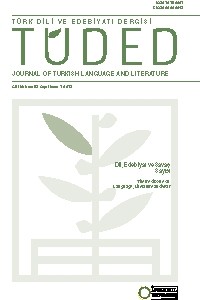Edebiyat Eserlerini Anlamak ve Yorumlamak İçin Farklı Bir Yöntem: Einfühlung Teorisi
Einfühlung, empati, özdeşleşme, T. Lipps, estetik.
-
Einfühlung, empathy, identification, T. Lipps, aesthetic.,
___
- AFÎFÎ, Prof. Dr. Ebu’l-Alâ, Tasavvuf: İslam’da Manevi Devrim, (Çev. H. İbrahim Kaçar-Murat Sülün), Risâle Yayınları, İstanbul, 1996.
- AKARSU, Prof. Dr. Bedia, Felsefe Terimleri Sözlüğü, Türk Dil Kurumu Yayınları, Ankara, 1975.
- AYVAZOĞLU, Beşir, İslam Estetiği ve İnsan, Çağ Yayınları, İstanbul, 1989.
- BAUDRİLLARD, Jean, Nesneler Sistemi, (Çev. Oğuz Adanır- Aslı Karamollaoğlu), Boğaziçi Üniversitesi Yayınevi, 2. bsk., İstanbul, 2011.
- BAVELAS, J.B. ; Black, A., Lemery, C.R., Mullet, J., “Motor Mimicry As Primitive Emphaty”, Emphaty and its Development, (Ed. Nancy Eisenberg-janet Strayer), Cambridge University Press, USA, 1987, pp.317-338.
- BOLUTER, Lawrence R. , “Emphaty”, Encyclopedia İnternational, v.6, Grolier, USA, 19 BUDAK, Selçuk, Psikoloji Sözlüğü, Bilim ve Sanat Yayınları, Ankara, 2005.
- CEVİZCİ, Ahmet, Felsefe Sözlüğü, 6. Bsk, Paradigma Yayınları, İstanbul, 2005.
- COOPER, Bridget, Emphaty and Education: Engagement, Values and Achievement, Continuum, G. Britain, 2011.
- DAVİS, Carol M., “What Is Empathy, and Can Empathy Be Taught?”, Physical Therapy, November 1990, vol. 70, no. 11, p. 707-711.
- DEMİRCİ, Kürşat, “Hulûl” mad., TDİA, c.18, İstanbul, 1998, s.340-342.
- DEPEW, David, “Empathy, Psychology, and Aesthetics”, Poroi, v.4, issue:1 March, 2005, s.106-107.
- ECO, Umberto, Ortaçağ Estetiğinde Sanat ve Güzellik, (Çev. Kemal Atakay), Can Yayınları, İstanbul 1998.
- (ERTUĞRUL), İsmail Fenni, Vahdet-i Vücût ve İbni Arabi, Orhaniye Matbaası, 1928. FAUVEL, Lysane Françoise Arlette, “The Archeology of Empathy”, Philosophy Department Unpublished Doctoral Dissertation, Stony Brook University, USA, 200
- GRİBBLE, James - OLİVER, Graham, “Emphaty and Education”, Studies in Philosophy and Education, Summer, 1973, Vol. 8, Issue 1, pp 3-29.
- GÜLSEREN, Dr. Şerif, “Eşduyum (Empati): Tanımı ve Kullanımı Üzerine Bir Gözden Geçirme”, Türk Psikiyatri Dergisi, c. 12, nr.2, Yaz 2001, s. 133-145.
- HUNSDAHL, Jorgen B., “Concerning Einfühlung (Empathy): A Concept Analysis Of İts Origin and Early Development”, Journal of the History of the Behavioral Scinces, v.3, issue 2,1967, pp.181-191.
- KARAGÖZ, Dr. İlknur, “Yahya Kemal’in “Ses” Adlı Şiirinin Özdeşleyim (Eınfuhlung) Metoduyla Tahlili”, Tüba, nr. XVIII-/2005-Güz, s.163-177.
- KEEN, Suzanne, Emphaty and Novel, Oxford University Press, USA, 2007.
- KOBYA, Elif Şebnem, “Tebrizli Şems’in Feracesinin Özdeşleyim Kuramına Göre İncelenmesi”, A. Ü. Türkiyat Araştırmaları Enstitüsü Dergisi, nr. 47, 2012, s. 189-196
- KRAUSE, Rainer, “An Update on Primary İdentification,İntrojection, and Empathy”, International Forum of Psychoanalysis, v. 19, issue 3, 2010, pp. 138-143.
- MATSUMOTO, David, The Cambridge Dictionary of Psychology, Cambridge Ünivesity Press, USA, 2009.
- NOVAK, Magdalena, “The Complicated History of Einfühlung”, Argument, Vol.1, 2/2011, pp.301-326.
- OLİVER, James Gribble-Graham, “Emphaty and Education”, Studies in Philosophy and Education, Summer, 1973, Volume 8, Issue 1, pp 3-29.
- SCHEUNEMANN, (Ed.)Dietrich, Avant-Garde/ Neo-Avant-Garde, Rodopi, Netherlands, 2005.
- STUEBER, Kartsen R., Rediscovering Emphaty: Agency, Folk Phsycology,And Human Sciencs, Bradfoord Books, USA, 2006.
- Şemsettin Sami, Kamus-ı Türkî, İkdam Matbaası, Dersaadet, 1318.
- Şeyhzade Burhan, “Bedii Hulûl: Einfühlung”, Görüş, c.1, nr.2, Eylül 1930, s.79-91.
- TANPINAR, Ahmet Hamdi, Edebiyat Üzerine Makaleler, MEB, İstanbul, 1969.
- TİMUÇİN, Afşar, Felsefe Sözlüğü, 2. Bsk., İnsancıl Yayınları, İstanbul, t.y. TUNALI, İsmail, Estetik, 3. Bsk., Remzi Kitapevi, İstanbul, 1989.
- ÜNAL, Dr. Cavit, “İnsanları Anlama Kabiliyeti”, Ankara Üniversitesi Eğitim Bilimleri Fakültesi Dergisi, c.5, nr.3, 1972, s.71-93.
- WORRİNGER, Willhelm, Soyutlama ve Özdeşleyim, (Çev. İsmail Tunalı), Remzi Kitabevi, İstanbul, 1985.
- WİLLHELM Worringer, Soyutlama ve Einfühlung: Üslup Psikolojisi Üzerine Bir Araştırma, (Çev. İsmail Tunalı), İstanbul Üniversitesi Edebiyat Fakültesi Yayınları, İstanbul, 1963.
- WORRİNGER, Willhelm, Abstraction and Emphaty, (Çev. Michael Bullock), Elephant Paperback, USA, 1997.
- “Fühlen”, (Çevrimiçi) http://www.duden.de/suchen/dudenonline/einf%C3%BChlen 2013.
- “Einfühlung”, (Çevrimiçi) http://www.almancasozluk.net/index.php?q=einf%C3%BChlung 2013.
- ISSN: 1015-2091
- Başlangıç: 1946
- Yayıncı: İstanbul Üniversitesi
Toplumsal ve Siyasi Değişim Açısından Sultan Hamid Düşerken Romanı
Çaştanı Bey Hikayesi'ne Ait Yeni Belgeler
Kasîde-i Masnû'a İle Bedî'iyye Aynı Şey Midir?
Edebiyat Eserlerini Anlamak ve Yorumlamak İçin Farklı Bir Yöntem: Einfühlung Teorisi
Türk Edebiyatında 12 Eylül 1980 Askeri Darbesi'ne Postmodern Yanıt
Divan Şiirinde Harf ve Kelime Oyunlarına Dair Bir Tasnif Denemesi
Çağatay Türkçesi Dilbilgisi ve Metin Çalışmaları
Türk Dili Öğreticisi Olarak Kaşgarlı Mahmud ve Öğretim Metodu Açısından Dîvanü Lugati't-Türk
Sezai Karakoç'un Hatıralar'ı Işığında Necip Fazıl Kısakürek Portresine Çerçeve Arayışı
